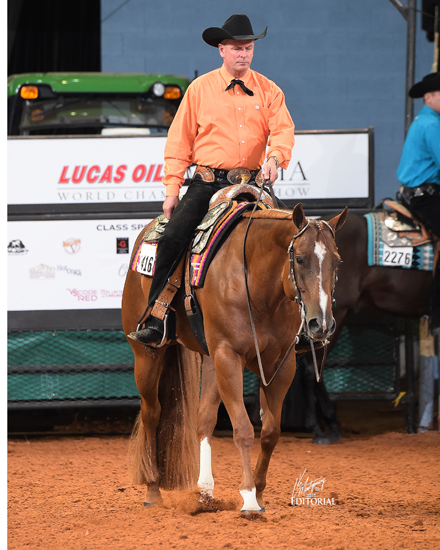
2016 AQHA World Champion Only A Breeze & Rusty Green
The Western Pleasure class has long been a source of controversy with critics complaining about excessively slow gaits, over canted bodies and, most of all, head sets.
“Over the years, the most dominant class that we’ve received complaints on, and maybe rightfully so, has been the Western Pleasure classes,” said Alex Ross, the Senior Director of Judges and Stewards for the American Quarter Horse Association. “But in the recent, five years or so, we’ve seen a dramatic improvement in the headsets.”
WESTERN PLEASURE
Straight from the AQHA 2016 Official Rulebook: (excerpts that relate to head carriage)
SHW402. WESTERN PLEASURE
… He should carry his head and neck in a relaxed, natural position, with his poll level with or slightly above the level of the withers. He should not carry his head behind the vertical, giving the appearance of intimidation, or be excessively nosed out, giving a resistant appearance. His head should be level, with his nose slightly in front of the vertical, having a bright expression with his ears alert. He should be shown on a reasonably loose rein.
SHW413. Faults to be scored according to severity: (excerpts that relate to head carriage)
Head carried too high
Head carried too low (top of ear below the withers)
Overflexing or straining neck in head carriage to the nose is carried behind the vertical
Excessive nosing out
Excessive movement of the top line at the lope
SHW414. Faults that will be cause for disqualification, except in Level 1 amateur or Level 1 youth classes, which shall be faults scored according to severity:
Head carried too low and/or clearly behind the vertical excessively and consistently while
the horse is in motion, or otherwise showing the appearance of intimidation.
As in any class, Ross explains that you will always have the exceptions, however he feels that, as a whole, our industry is showing horses as a much better example of our rules governing the class. “I’m not saying that it’s all perfect,” Ross explained. The judges’ application of the rules over the last few years has encouraged exhibitors to be better in their presentations. The exhibitors seem to be saying “Tell me how you will judge and that’s how I will perform.”
“We have to be careful not to penalize a horse when it’s not warranted,” he cautions. “If you have a horse that is relaxed, and comfortable in his job, there’s a good chance that he will walk, and maybe even jog, with his head slightly below the line our rulebook draws. Most judges are not going to have an issue with that, as long as that horse does not look intimated.”
With concerns over animal welfare, we have to realize that if we demand the heads are in an exact position all of the time, we have to understand that it could encourage overtraining to lift a horse that’s perhaps going to naturally carry his head slightly below level because that’s where his comfort zone is.
“We want to be cautious to not over-enforce the rule simply to meet the sentence in the rulebook,” Ross said.
That all said, the head carriage at the lope is different. In order for a good loper to have the self carriage needed to be exemplary, he’s going to need to lift his neck and shoulders to engage that hock. That’s going to put his head and neck where our rulebook states in order to perform the lope to earn maximum credit from the judge.
“The stride starts from behind,” explained Ross. “The more balanced the horse is the easier it will be for him.” The gait faults we see such as dwelling the front leg, leaving the off hock behind, or head bobbing all show up in a horse that’s not balanced and correct. Having the head and neck where the poll is level or slightly above the level of the withers is going to give that horse room to be in a correct frame. It all relates to that important self carriage.
Watching the classes at the recent 2015 AQHA Lucas Oil World Championship Show, Ross was extremely pleased with the classes and the horses overall in all of the Western Pleasure classes.
“The 2-year-olds, as a whole, were the best group I’ve seen in recent years,” he said. “That is difficult; there are always a lot of opinions on that class, but overall, that was a nice set of horses.”
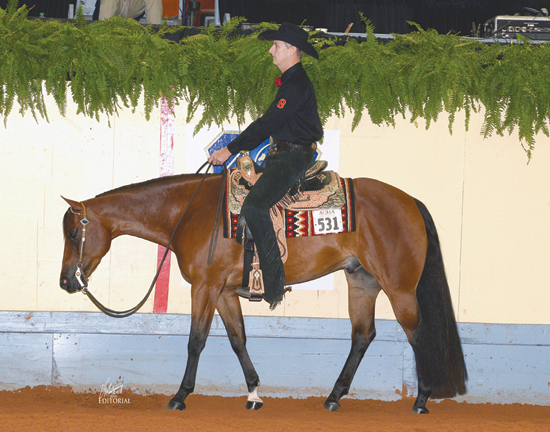
Gil Galyean & Rewind and Repeat
Newly honored NSBA’s Million Dollar Rider and AQHA Professional Horseman, Gil Galyean, presented his thoughts on western pleasure at the Nutrena Ride The Rail clinic held during the 2015 Lucas Oil AQHA World Championship Show. He described what he looks for in a western pleasure horse, including the headset.
“You don’t want to have that horse to use his head and neck to take the next stride, it’s got to be steady,” he expained. “That’s what separates the better horses.”
As an exhibitor, Galyean understands that judges are looking for flow, rhythm and self carriage in the Western Pleasure horses.
“The judge has to place the class, so he has to look for things he finds appealing,” he said.
Galyean said when the headset is too low, the horse will tend to be heavy on the front end, again impeding the flow, movement and self carriage that is desirable.
“You’re not going to be able to compete if the head is too low; the judges are not going to find it appealing,” he said.
The National Snaffle Bit Association’s general explanation of a desirable Western Pleasure horse is fully in line with that of AQHA. … The overall picture of a good mover is a horse that goes forward with comfort, self carriage, confidence and willingness… and a head and neck carriage that is naturally comfortable and compatible with the horses’ conformation.
“Judges have to consider the overall correctness of the horse’s presentation in every class they judge,” said Stephanie Lynn, NSBA director of operations. “This makes it difficult to discuss only one aspect of the overall presentation. The judge’s number one priority is to recognize and reward excellence. Focusing on only one characteristic of the performance tends to lead to poor judging.
For example, she added, it is impossible for judges to consider the position of a horse’s head carriage without considering the horse’s conformation, way of going and how the head position affects the overall presentation. It is the judge’s job to decipher the best overall performance. And head carriage is just one aspect of the performance.
“Most horses, when presented with their heads too low or too high, lose their self carriage,” Lynn said. “A low head is often the first indicator that a horse is balancing off his or her front end while a horse carrying his or her head too high hollows out their back. Hunter Under Saddle horses should appear happy and natural as reflected in their attitude and seen in their expression, ears and mouth. Horses that move in an artificial frame should be penalized.”
Lynn added that the important thing for exhibitors to remember is that every horse must be evaluated in the context of the entire class. Judges have to look at the whole picture when assessing the class and ranking the performances. They are looking for the horses that best combine the positive characteristics of the class standard.”
The NSBA Rulebook goes into greater depth when describing the top line of a western pleasure horse.
- e) THE TOP-LINE:
1) Poor Top-Line: The horse’s head may be too high or too low. If the horse’s head is consistently higher than his eye level with his withers, his back becomes hollow and he loses his drive from behind. When his head is consistently lower than his ear level with his wither, he becomes heavy on his forehand and has no lift or flow. In both cases the horse loses his self-carriage and appears to struggle.
2) Average Top-Line: A horse who generally display’s a level top-line with the tip of the ear level with the wither at the lowest point or his eye level with the wither at the highest point but is inconsistent with his head carriage.
3) Good Top-Line: This horse will display a level top-line with the tip of the ear level with the wither at the lowest point or his eye level with the wither at the highest point. He also displays a consistent top-line that exhibits self-carriage.
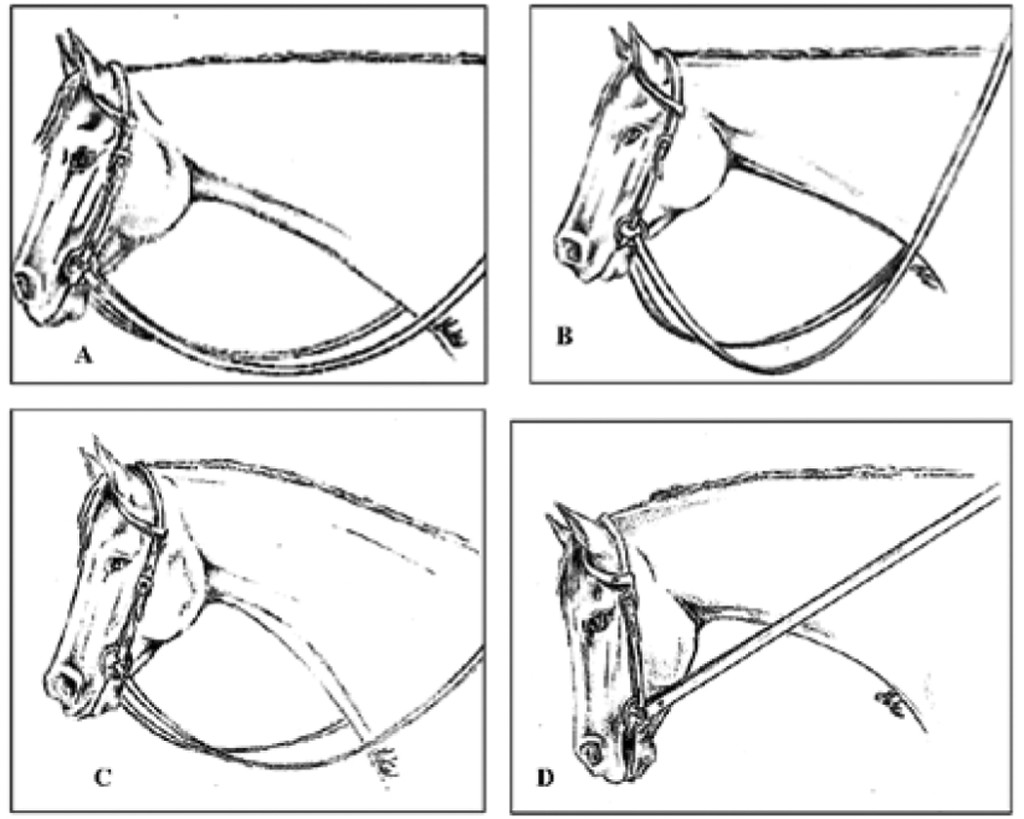
2016 NSBA Rulebook
NSBA Examples of Head Positions (from Rule Book)
- A) Proper head and rein position.
- B) Acceptable: should be rewarded if head carriage is normal.
- C) Not acceptable: head in improper position – should be severely penalized.
- D) Not acceptable: reins too tight – straight line from bit to hands – should be severely penalized.
HUNTER UNDER SADDLE
Straight from the AQHA 2016 Official Rulebook: (excerpts that relate to head carriage)
SHW601. HUNTER UNDER SADDLE
… The poll should be level with, or slightly above, the withers to allow proper impulsion behind. The head position should be slightly in front of, or on, the vertical.
SHW603. Faults to be scored according to severity: (excerpts that relate to head carriage)
Head carried too high
Head carried too low (top of ear below the withers)
Overflexing or straining neck in head carriage to the nose is carried behind the vertical
Excessive nosing out
SHW604. Faults that will be cause for disqualification, except in Level 1 amateur or Level 1 youth classes, which shall be faults scored according to severity:
Head carried too low and/or clearly behind the vertical excessively and consistently while
the horse is in motion, or otherwise showing the appearance of intimidation.
The NSBA Rulebook offers two examples of proper head positions for Hunter Under Saddle horses.
“Again, we’ve made drastic improvements in our headsets in the Hunter Under Saddle classes too,” said Alex Ross. “The horses look good as a whole. They are completing their stride at a walk, track up at the trot and canter with flow. Their head carriage is much better than it used to be.”
At the 2015 AQHA Lucas Oil World Championship Show, several of our specialized over fence judges watched the hunter under saddle rail classes and agreed they liked what they saw – the horses were moving forward, were very pleasing to the eye and looked like they could go on to do over fence work – which may be the next step in the career path of many hunter under saddle horses.
When you look at a horse and your immediate reaction is that horse’s head is too low, then it’s too low. It’s unnatural and overtrained. “That’s where common sense plays in,” said Alex. “If it’s excessively low, it’s so unnatural and it’s not pleasing to the eye.”
When a horse is consistently in violation of the rules, the judge has to judge it within the parameters of our rulebook. Ask yourself, “Do we want to see every horse come to the horse show like that?” If the answer is no, then the judge has to apply the rules and fault the horse accordingly.
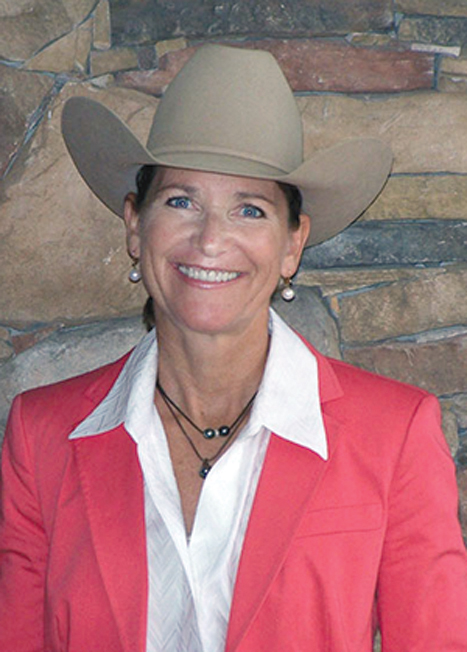
Stephanie Lynn
WESTERN RIDING
The Western Riding classes have become so tough competitively with a high degree of difficulty. They horses are moving forward with good self carriage and really look good these days.
Ross shared the four qualities that will place a horse in the +1 or +1-1/2 credit earning positions as (1) great mover, (2) great lead changer, (3) good expression, and (4) guides well.
“We’re seeing a lot of horses that can meet these elements and make it look easy,” he said. When any of these fall short, it will be reflected in that score.
TRAIL
“The courses have become more challenging and the trainers and horses are making it look amazingly easy,” says Ross. “Their quality is being reflected in the scores we’re seeing when the exhibitor shows their horse to the best of their ability.”
Again, headset and self carriage are factors that will affect the credit a horse earns.
“If that horse is over schooled, or hiding behind the bridle, especially in the gaits between obstacles – it should have a negative effect in the maneuver score,” Ross said.
TRAINER PERSPECTIVE
“As far as the training aspect, the head position is one of those things that I focus on right from the start,” explained Adam Wainscott, AQHA Professional Horseman. “It’s part of figuring out where each horse has strong points or weak points. And it’s helping him learn to carry himself right from the start.”
And balance plays an important role.
“You will find that a horse that uses his head and neck a lot has a balance issue, either they are not holding their back up or are unbalanced so that they are pulling themselves with their front end. Each individual horse is different; some can go really slow and hold themselves and some just need to go that notch faster.”
Wainscott said he believes that breeding has a big influence on headsets.
“The horses we are breeding for Western Pleasure are producing the conformation that makes it easier for those horses to do what we want,” he said. “We want their necks to tie in at that right spot that allows the horse to travel with his head and neck where the guidelines for Western Pleasure say it should be.”
That’s when training comes into play.
“When you, as a trainer, are lucky enough to have one with the right conformation and the physical talent, then it’s up to you, as the trainer, to not get in that horse’s way, to not hinder that natural place where he holds his neck.”
Wainscott reminds trainers and exhibitors that just because they want a particular horse to be a Western Pleasure contender does not mean that it’s going to be the perfect job for that horse.
“Western pleasure was designed to be a stepping stone into the other events like Trail, Western Riding and Horsemanship,” he said. “All of these show horses will benefit from Western Pleasure training, on their way to becoming a show horse.”
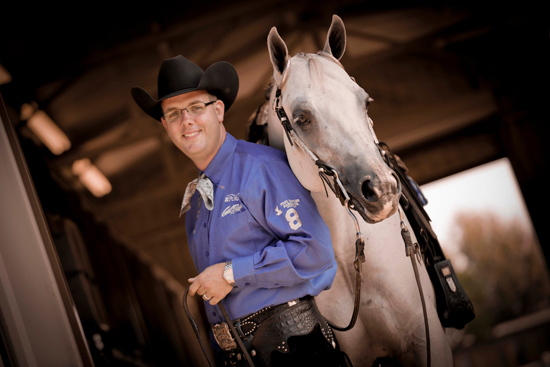
Adam Wainscott
Wainscott said it’s important to keep in mind what we are asking our horses to do.
“We have to agree that nothing we ask a show horse to do is natural – dressage maneuvers are not natural, spinning several times fast is not natural, sliding 20 feet in the dirt is not a natural act for a horse to do. But a horse show is a SHOW,” says Wainscott. “Society has become very judgmental, especially in the social media where we can be bombarded by opinions, many times from individuals hiding behind keyboards without a true understanding of our industry.”
It can be difficult to bridge the gap between the championship shows and the weekend shows, Wainscott admits.
“We should realize a great thing about our industry is there are so many different places and ways for riders and horses to compete,” he said. “It’s the same as any other sport. There are kids out there playing football, baseball, doing gymnastics. Not all of them are going to end up in the NFL or go to the Olympics. And that’s perfectly OK. Horses can teach people so many lessons on life. That’s the real benefit.”
The horses that we see at the World Championship Show, for instance, should be exceptional individuals, they are there because they’ve proven themselves to be exceptional horses. The horses you may see at a weekend show may not look the same as those top ten World Show horses.
“I tell my clients that we do our homework at home and the show is the test,” he said. “It’s where we see if what we are doing is working in our training and if we are improving. We’d like to have the judges appreciate our horses and reward us in the show pen, but it’s really more about personal goals and achievements, whether that personal goal is a year end high point award or to just navigate that class better than the show before.”
Wainscott believes judges are benefitting from improved education.
“Judges have to weigh out a lot of factors when they are standing in the middle of an arena judging a show,” he said. “They have to judge what’s in front of them, in a very short amount of time. Some horses want to carry their heads lower, some are going to be higher, some carry their noses out a bit and some are more comfortable straight. That judge has to decipher a lot while choosing horses that meet the standards set by our rulebook.”
But Wainscott thinks horses look way better today than they did 10-20 years ago.
“I’ve been in arenas all over the country, and the horses I see are all fat, slick and shiny,” he said. “They’re not missing hair from their jaw, or showing big spur marks on their sides. They’re getting trained and cared for better these days.”
Wainscott credits the AQHA Steward Program for helping our industry to be a positive example. He sees the issues that perhaps prevent a horse from that perfect headset are normally physical. Sometimes it’s an injury or physical limitation, such as a spur in a hock, that creates an issue making it difficult for a horse to hold his head and neck steady.
“If I have a horse that’s showing a problem, the first place I go is their mouth and teeth,” Wainscott said. “If they are holding their head funny, or resistant to the bit, we check out their mouth and teeth first then a chiropractor. Horses are like people, their bodies can get out of whack and then they compensate for a sore area and throw their balance off.”
Wainscott doesn’t pin the headset as the end all/be all judging factor of pleasure horses.
“It has always been my belief that it doesn’t matter if your horse isn’t as good as another one in one area, there’s always positives,” he said. “And you have to focus on their positives and build on them, even if they struggle in some spots. It’s like the kid who isn’t very good in algebra. If you continue to pound in that he’s no good at algebra, he’s never going to be good at algebra.”
Wainscott is quick to tell exhibitors and young trainers to not get discouraged by negative comparisons between local, weekend show horses to World Show horses. It’s true that at the weekend shows, not every horse is going to be the exemplary model of the AQHA rulebook on Western Pleasure. But that shouldn’t get in the way of individual personal goals and achievements.
“Everyone’s just trying to do the best with what they’ve got,” he said. “All of us trainers, at whatever level we compete, are working to make a living and doing the best that we can for our horses.”
EXAMPLES OF THE IDEAL
“The Senior Western Pleasure class at the (AQHA) World Show was a great class,” says AQHA Judge Brent Tincher, who presided over several classes at the 2015 AQHA World Show. “I feel those five horses really emulated what we are looking for: they looked like a quarter horse, they were fresh and were interested in their job. The sorrel mare that won looked like a World Champion.”
“I was immediately drawn into her,” said Tincher of the eventual Senior Western Pleasure World Champion. “That first impression was outstanding; she had expression and self carriage as she came down the center of the pen.”
“Those top three horses were good examples on my card for the class,” explained Tincher. “They were correct, they met the rule requirements and they were special doing it. At the walk, the profiles – they were meeting our rule requirements with self carriage and looking through the bridle. Both the sorrel mare and the black gelding showed excellent self carriage throughout the class.”
Tincher noted the toplines at the lope kept a pretty profile as well.
“The 2-Year-Old Western Pleasure Class at the World Show may have been my favorite pleasure class to see this year,” he admitted. “They were outstanding and a very good group. There were a few of them in the prelims that may have been a bit more bridled up but in the finals, they all came in softened in the bridle, with their necks up and moving forward.”
Looking back at the NSBA World Show last summer, Tincher spoke very highly of the 2-year-olds showing in the Western Pleasure.
“Normally there are very few 2-year-olds that already are great pleasure horses, it takes until they are 3, 4, 5 or 6,” he said. “But this year’s group was solid, and I’m kind of proud where we are with our pleasure horses.”
An emphasis on life after the rail events seems to have had an impact.
“I think one of the reasons our horses are getting better is where our industry is heading – toward the all around events after starting in Western Pleasure,” Tincher said. “With more emphasis on the horse’s career beyond the Western Pleasure, we’ve taken some of the pressure off of the 2-year-old futurities and the elementary training as they are started has improved. Focus on long term goals has been a big benefit to our horses and the training.”
Tincher agrees that breeding has some influence on the Western Pleasure horses, but perhaps in a different way than others. “I think rather than breeding for that flat knee, we are breeding horses that are a more structurally correct, foundation type and moving back to the ideal conformation. Flat knees may not always be structurally sound. The colt that won the 2-Year-Old Western Pleasure (at the AQHA World Show) looked like a little cutter, he was stout.”
The industry trend of breeding fewer horses certainly has had an effect on today’s show horses. Cutting down on the mares bred means that probably better mares are being bred, producing better offspring. Tincher credits the mare for 85 percent of that foal – in both physical and mental traits.
“I feel like we are doing well on the headsets,” he said. “We need to remember that at the weekend and smaller shows, we will find some horses that might not meet the rule requirements but realize that average horses have value to the industry. We’re not all great athletes or good dancers. But these horses need to have a job, and if they are enjoyable for someone learning to ride then they are useful.”
The horses presented at the World Championship Shows are the cream of the crop, there’s no doubt. But not every horse shown will live up to the examples we may see at the World Shows, and that’s OK. When judging below average horses, Tincher explains that it becomes personal preference.
“You will find nice horses at a weekend show,” he said. “First you look for the ones who are meeting the rule requirements for the class. Then I go to obedience.”



You must be logged in to post a comment Login